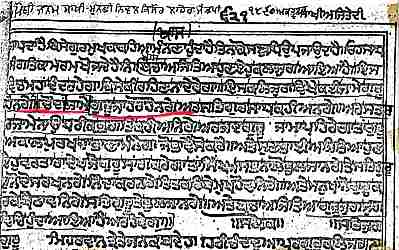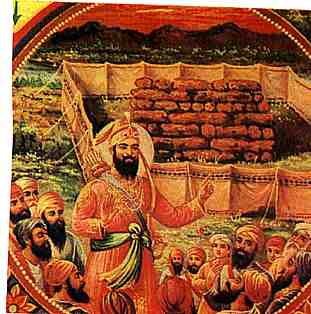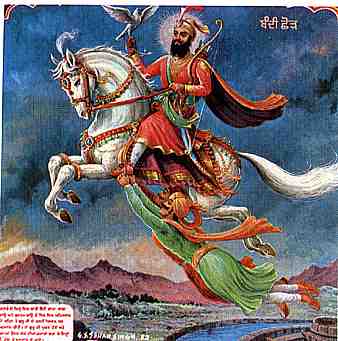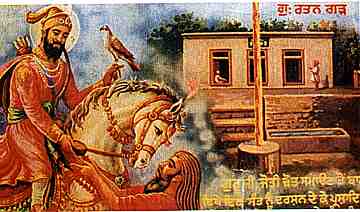The Namdhari Sikhs believe that Guru Gobind Singh did not die at Nanded, but made a secret exit from the funeral pyre and eventually settled in Nabha, where he stayed for 103 years under the guise of Baba Ajaypal Singh. During this period he met Baba (Guru) Balak Singh at Hazro Sahib and conferred the 'Gurgaddi' on him.
To substantiate this claim, the following historical evidences are presented below:-
1. The Janam Sakhis of Guru Nanak, which are written during the Guru periods, long before the founding of the Namdhari Sikhs, narrate the coming of 14 Gurus and 70 Bhagats e.g. "Sattar Jaame Bhagat Jan, Chaudan Satgur Rai". These Janam Sakhis range from the "Bala" version to the Sant Dass Chhibber's "Janam Sakhi Nanak Sah Ki", which was written in 1777 AD and printed by "Publication Bureau"-Punjab University, Patiala in 1985 AD. It is edited by Dr. Gurdev Singh. The following 'Saloka" appears on page 460 :-
slok m: 1
jwmw phr jgo mY bYTw sgl proeI sUq[AMDkwr dIpk prgwisAw mrm nw jwinAw dUq [1[
siqgur ivc jwmY caurwsI [ pihry hY siqgur AibnwsI [
qRyqy my BI soeI jwn [ duAwpru BI sm lyhu pCwn [
Ab kl mY BI AsI cwr [ jwmY pihrygw inrDwr [
iqn mY cEdW pRgt pCwno [ sqr gupq Bgq idRV jwno [
naumy sWg su BwrI jwn [ bhuq BrmY go isK Ajwn [
In another Janam Sakhi of Bhai Bala, which was printed in 1890 AD in Lahore by Munshi Naval Kishore Printers , the following 'Saloka' endorses the above 'salokas' from the Chibber Janam Sakhi.

There are many other hand-written and printed versions of Janam Sakhis, which clearly disclose the foretelling of the fourteen Gurus.
2. Dr. Surinder Singh Kohli has written a book "Sikh Predictions", published in 1998. In this book there are quite a few pointers to the fourteen Gurus and other relevant excerpts, which are given below:-
Page 33 (Sikh Predictions)
"A brief dialogue of Ajitta with the Guru has also been recorded in 'Sikhan di Bhagat Mal' of Bhai Mani Singh, which is a commentary on the eleventh Var of Bhai Gurdas."
The following prediction is mentioned in this Gosht: "The true Guru comes in every age for eighty-four times. He did so in Satyuga, Treta and Dwapara. He will also manifest himself for eighty-four times in Kaliyuga, manifesting fourteen times prominently and seventy times incognito as saints."
On Page 38, Dr. Kohli writes; "
"Gurindnama"
The word 'Gurind' means Guru. This work briefly describes the birth and life of the twelfth manifestation of the true Guru in Kalyuga. Regarding the eleventh manifestation it only says that he will remain incognito, The twelfth manifestation will take place in the world in the year 4897 of Kaliyuga or the Prabhva Samvat 1853. Some facts mentioned in this work are:
1.The eleventh manifestation will take place in Bijapur.
2. In twelfth manifestation the Guru will promulgate in the world the discipline of the Name of the Lord in Prabha Samvat 1917.
3. The twelfth manifestation will be very powerful one. He will bring Satyuga in Kaliyuga.
4.He will have long hair on his head and a rosary around his neck. He will be the protector of the lowly and destroyer of the Malecchas.
5. He will reside on the banks of Sutlej and will go to Hari-Mandir after conquering the Baghdad in the Middle-East.All the world will bow befor him.
There seems to be some confusions regarding the years and Samvats mentioned in this work.
On Page 64 of the Sikh Predictions:
"There will be the son of a carpenter in the abode of the Ril Clan He will be very powerful and rule the land. The Punjab will have adopted the way of the Shudras. He will revive the Panth at the time."
On Page 65, he writes regarding the age of the 12th manifestation;
"For two hundred and fifty years his body endured."
On Page 69, in his commentary Dr. Kohli writes;
"There is a very brief mention of the son of a carpenter of the Ril clan, who will be very powerful and will rule over Punjab and other parts of India. The Namdhari Sikhs consider it referring to Baba Ram Singh Ji, who had disappeared from his exile in Rangoon (Burma) in 1885 and is said to reappear again."
On page 84, Dr. Kohli, comments on the Sau Sakhi's 51st Sakhi;
"4. But the mention of the '58th year of the Ganga' and Dalip Singh also are a pointer to the fact that this Sakhi refers to the present period. Namdhari Sikhs believe that the mention of 'Ram Singh' in this Sakhi is meant for Baba Ram Singh, who, according to them, disappeared from his exile in Rangoon and is due to return."
On page 102, commentary on the 65th Sakhi of Sau Sakhi, Dr. Kohli writes;
"5. To a query by Alam Singh the Guru said that he would come as the eleventh Sikh Guru, when no body would be able to recognise him. We have seen earlier the same fact recorded in 'Gurind Nama' that the eleventh Guru will remain incognito.
6. The Guru says that he would come again, when the obstinate, mysterious and foolish kings would perish. He would also send five of his true Singh Sardars, but did not want to elaborate this point. This may be a pointer to his second coming at a later date as the twelfth Guru."
The above extracts have been taken, as previously mentioned, from "Sikh Predictions" by Dr. Surindar Singh Kohli.
An excerpt follows, which is in the book "Textual Sources for the Study of Sikhism" by W.H. McLeod, which gives various reasons on the controversial issue of Guru Gobind Singh's death.
THE NAMDHARI SIKHS Namdhari Sikhs are easily recognised by their practice of wearing white homespun clothing and by their method of tying the turban horizontally across the forehead. Around their necks they wear a white woollen cord (mala), woven as a series of 108 knots and serving as a rosary. Their distinctive rituals include the fire ceremony (havan) which is described below and the practice of circumbulating a fire during the course of their wedding ceremony. The orthodox belief that the line of personal Gurus ended with the death of Guru Gobind Singh is denied by the Namdharis. They insist that the tenth Guru lived for many years after 1708, eventually bestowing the succession on Balak Singh of Hazro. The Namdhari Sikhs are strict vegetarians and vigorous protectors of the cow. They attach equal importance to the Adi Granth and Dasam Granth, and they include the Dasam Granth composition Chandi di Var in their daily nit-nem. [2
6.2.1. The history and doctrines of the Namdhari Sikhs The historical evidence enables us to affirm categorically that in Nander Guru Gobind Singh repeated in a more dramatic way the stratagem, which he had earlier used when escaping from Chamkaur. It is clear from the evidence that the Guru did not die in Nander (2.2.8[16]) but that he was able by means of a ruse, to escape under cover of darkness. .
But why did the Guru decide to depart alone and under such mysterious circumstances? The reason was that the Mughals were pursuing him. According to Lala Daulat Rai..... Bahadur Shah [the Mughal emperor], hoping to sweep all obstacles from his path, had hatched a plan to attack Guru Gobind Singh. Prompted by intuition the Guru was able to foresee the Emperor's evil design and realising what was afoot he slipped away from Nander during the night. There is no reliable historical work which suggests (a) that the Guru died in the presence of his Sikhs; (b) that the Sikhs placed his corpse on the funeral pyre; or (c) that the Sikhs actually performed his cremation by setting light to the pyre. What history does tell us is that the Guru, still alive, sat on the pyre and then ordered his Sikhs to leave the enclosure, which had been constructed by placing screens around the pyre. Indeed, he went even further than this. He sternly commanded them to stand with their backs to the enclosure after they had left it. What was the point of having a screened enclosure erected and then insisting that his Sikhs, having left it, should stand with their backs to it? There can be no doubt that it was because the Guru wanted to slip away as he had done at Chamkaur; and that he wanted to do this in order that he might thereafter live in disguise.. . .

What actually happened was that after his mysterious disappearance from Nander the Guru continued to move around the country. Until he finally departed this life in S. 1869 [1812 AC.] he continued, as previously, to assist his Sikhs in whatever trials they might encounter.
The first indication which the histories offer of his activities after leaving Nander concerns the two Raj put chieftains Rustam Rao and Bala Rao. Heeding their prayers for assistance the Guru carried them safely out of the Satara fort, each clinging to one of his stirrups. He then took them back to their own area. ...


Once during this Nabha period, and under this guise, the Guru visited the Attock area. There lived in that area Balak Singh, son of Dayal Singh of Hazro. Ever since his early childhood Balak Singh had been absorbed in the worship of God, but although he had led a saintly life he still felt the need of finding a guru who could provide him with spiritual satisfaction. At that time he was still only twelve years old. His father had a shop in the village of Chhoi and Balak Singh was frequently required to make the journey from Sarvala to Chhoi. Early one morning he set out for Chhoi, following the road which would lead him past the place where the Haro stream joins the Indus river. Sant Indar Singh Chakravarti takes up the story:
This is a supremely peaceful spot, a delightful place of great beauty. Ahead lies a magnificent view of Mount Chhoi, a marvellous scene for anyone who appreciates the splendour of nature. In such a setting the restless mind is stilled and one's spirit is irresistibly drawn to the praise and worship of God. It was mid-morning by the time the devout Guru Balak Singh approached this place. As he came down to the river his mind was concentrated on the blessed feet of the Guru and while he was thus rapt in meditation he beheld Guru Gobind Singh riding a horse in the company of five Sikhs. He immediately grasped the reins and the Guru, having dismounted took the seat which was offered to him. Perceiving in his countenance features associated with the Tenth Guru, Balak Singh questioned him. Knowing full well what was in his mind, the Guru declared, 'Until now I have kept my identity a secret as it was felt better not to reveal it....'
Thus did the Tenth Master confer on Balak Singh the praise and adoration due to one divinely endowed. He proceeded to designate him his successor as Guru, laying five copper coins and a coconut before him and then prostrating himself.... Giani Gyan Singh relates the birth of Satguru Ram Singh (the twelfth Guru) in a particularly beautiful passage.... According to Gyan Singh he was born in the village of Bhaini Raian, Ludhiana District, on the fifth day of the waxing moon in the month of Magh, S. 1872 [1816 A.G.J. The birth took place in the house of his parents Jassa Singh and Sada Kaur.
Following a childhood notable for its marvellous achievements the youthful Ram Singh enlisted in the army of Maharaja Ranjit Singh. Together with his Brother-in-law Kabal Singh he joined the Naunihal Regiment and remained in the army until the first Anglo Sikh war [1845-6]. While serving as a soldier he devoted his spare time to singing God's praise, with the result that his unit came to be known as the 'Bhagat's Regiment'. Sant Nidhan Singh Alam describes how in 1841 Satguru Ram Singh happened to be quartered in Hazro while marching with his platoon to Peshawar on some official business. At that time Guru Balak Singh was delivering the divine discourses which were winning worldly souls to true happiness. While conferring the succession on him Guru Gobind Singh had told him that he would himself return as the twelfth Guru and reclaim it from him.
When Satguru Ram Singh visited Guru Balak Singh to pay his respects the latter was engaged in interpreting the hymn '1 have come for your protection, Master.' When Satguru Ram Singh prostrated himself in the usual way Guru Balak Singh said, 'Come, my Lord and Master! I have awaited your coming for a long time.' Joyfully he arose (he had been sitting behind the Granth Sahib) and lovingly embraced Satguru Ram Singh. He then introduced him to the assembled congregation and [initiated him by] whispering the divine mantra in his ear.. . . Guru Balak Singh then commissioned him with the sacred duty of preaching the message of deliverance to all who dwell in ignorance. Placing five copper coins and a coconut before him he entrusted him with the divine responsibility of serving as Guru. . .. [10
Thus the Guru's succession which had extended from S. 1526 to 5.1765 [1469-1708 A.C.] did not come to an end.... It continued to run, the inheritance passing trom Guru Gobind Singh through Guru Balak Singh to Satguru Ram Singh.